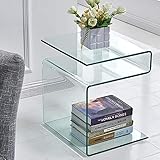Among the most important uses of glass in modern life is for tabletops – either as free-standing tops or as a way to protect wood or other tables. The benefits of glass tabletops can be divided into practical and esthetic (utility and beauty). Learn all about these amazing benefits in this post.
Glass tabletops are safe, affordable, protective, and easy to maintain & replace. Esthetically, they are stylish, modern, transparent, and highly versatile.
Glass tops – summary of benefits
Glass table tops have been a part of the interior design vocabulary for years following the invention of the float glass manufacturing and the increased affordability of glass. The benefits of glass can be divided into two categories: functional and esthetic:
Functional benefits of glass tops:
Five practical benefits of glass tabletops are:
- Protection: glass prevents stains, scratches & UV fading
- Safety: tempered glass is strong and heat-resistant
- Maintenance: glass is easy to clean & sanitize
- Affordability: glass is economically priced
- Replaceable: glass is easily replaced if scratched
If you are a designer or just a creative homeowner, glass tops have unique esthetic benefits.
Five esthetic benefits of glass tabletops
- Transparency: the key property of glass is its transparent clarity
- Modernity: glass is iconic in contemporary styling
- Versatility: glass tops can be used in commercial & residential settings and for numerous table types
- Variety: glass comes in various thicknesses, edges, and tints
- Creativity: the only limit to the use of glass is your lack of imagination!
As an Amazon Associate, I earn from qualifying purchases
Glass tops protect wooden furniture
One of the most important functions of a glass tabletop is to protect valuable wooden furniture. The worst fate that can befall your antique dining table or credenza is to get stained by a clumsy guest or scratched by a visiting relative. Stains and scratches are very hard to remove and the simple solution is to protect the wood with a clear glass tabletop.
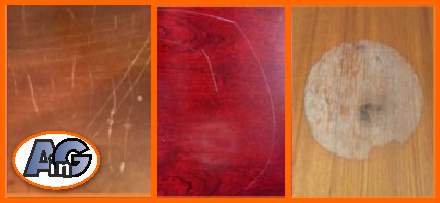
The commonest table to be protective is the dinner table but many other types can be protected including bedside tables, vanity tables, buffet or sideboard tables as well as more functional tables like writing desks, corporate conference tables, kids tables, and the all-purpose table for Mom’s craftwork or painting. The list is endless.

Glass tops are safe and hygienic
Glass is smooth and non-porous making it very easy to clean and sanitize (an especially valuable feature in this era of Covid):

Customers concerned about safety should choose tempered rather than annealed glass. Tempered glass is 4 times more impact-resistant (it is very hard to break even when struck with a hammer) and when it breaks it forms harmless popcorn fragments rather than jagged shards.
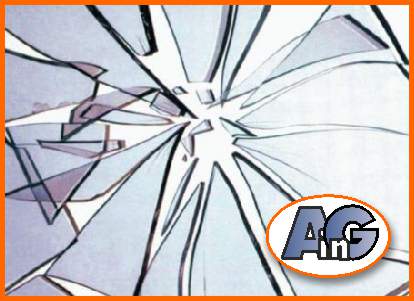
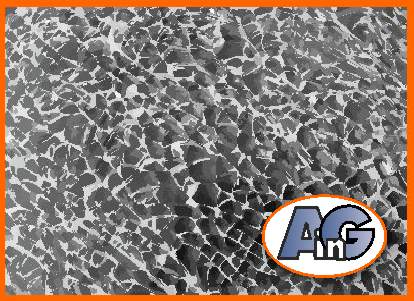
Tempered glass is also heat-resistant. We highly recommend using coasters or placemats to protect your glass from scratching but tempered glass can withstand large temperature gradients before cracking. So it will be safe to place a skillet or saucepan on a tempered glass tabletop. This is why tempered glass is mandated for stove backsplashes and for oven glass.
Learn all the facts about whether your glass tabletop should be tempered in this comprehensive post.
Why not use plexiglass to protect your table?
Various types of acrylic sheets are clear and will protect your valuable wooden table BUT plexiglass scratches much more easily and can be attacked by various chemicals.
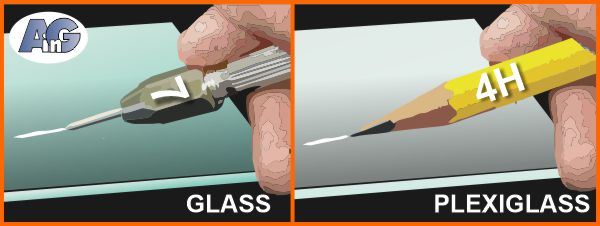
Finally, plexiglass is more expensive than regular tempered glass – so choose glass rather than acrylic to protect your tables.
Steve Jobs and the story of the scratched iPhone screen
A very interesting story about the scratch-resistance of glass came during the design of the first iPhone in 2007. Steve Jobs carried a prototype iPhone (with a plastic screen) in his pocket during the pre-launch period and was irate when he noticed that the screen had become scratched by rubbing against coins and keys in his pocket.
Steve ordered his design team to develop a glass screen in only six weeks. The shocked designers told Steve – glass is too risky – if the iPhone is dropped, glass being brittle, the screen will smash. But Jobs was insistent – using the following rationale: if the screen is scratched by keys and coins the customer will blame Apple for a design fault: however, if the screen breaks because the phone is dropped onto a concrete floor – the customer will consider this to be his fault – and blame himself not Apple,
Jobs got his way and Corning glass developed “Gorilla” hard glass for the iPhone – removing the problem of scratched screens,
Glass tops are easy to maintain
The hardness, smoothness, and non-porous nature of glass make glass tops very easy to maintain. The following care tips should be observed;
- Cushion the glass with plastic buttons or rubber bumpers
- Protect the glass with placemats
- Use approved glass cleaners (no abrasive pads)
- Clean regularly to avoid hard water stains
- Beware of sharp corners – order “radius” corners if necessary
Cushion the glass
Several types of plastic or rubber cushions are available for protecting your glass tops. Choose from the selection available on this Amazon product page.
For glass tops protecting or covering metal surfaces, like wrought iron or aluminum, we recommend adhesive rubber buttons this these shown below from Amazon:
These cabinet door buttons are thick enough to cushion heavy glass tops and to even out surface irregularities.
For 1/4″ thick protective glass on flat wooden surfaces, we prefer thinner plastic buttons like the ones shown below:
These non-adhesive buttons are our recommendation for protective glass on flat wood tops. Position them at 12″-18″ spacing around the perimeter of the glass.
Buttons serve the dual purpose of preventing the glass from slipping but also they allow air circulation between the glass and the wood. This is especially important with solid wood tabletops the wood can dry out asymmetrically and begin to warp if no air can reach the top.
Protect your glass with placemats
Glass is hard (moh’s hardness is 5-6) but it can be scratched by grit, sand, rough Mexican ceramics, and other hard substances like diamonds and gemstones – so it is a good idea to protect the surface with coasters or placemats.
Clean with care
Don’t use abrasive pads or cleaners – you will produce fine scratches that will turn the glass cloudy. Make sure to clean outdoor tables regularly to prevent the buildup of hard water stains caused by the evaporation of water. To get rid of cloudy glass – study the tips in this post.
Beware of sharp corners
Glass companies prefer to cut regular squares or rectangles because curves require more labor. However, if you have kids running around the house, sharp corners can be dangerous:
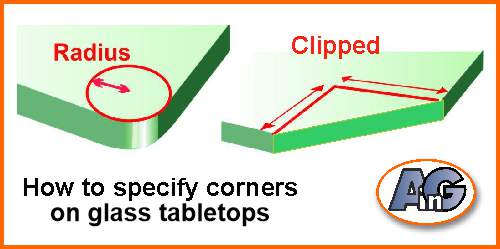
Use the drawing above to define the size of your rounded or clipped corners – or bring a tracing into your glass retailer. Be prepared to pay extra for corner rounding but specify “dubbed” or “eased” if you would just like the sharp corner sanded down.
Glass tops are affordable
The cost of clear glass depends on the thickness and the edgework. Although still good value, glass has recently risen dramatically in price:
Shock glass pricing update
Effective July, 2022 the wholesale price of float glass & mirror has increased by between 20 and 40% According to the USGLASS News Network: “The combination of material cost increases, supply chain disruptions along with other economic pressures has forced companies throughout the globe to raise prices. These volatile factors have also impacted the glass industry, which has recently seen major companies such as Guardian Glass announce price increases and surcharges. Guardian is not alone, as five other industry companies issued price increases. These include Viracon, Vitro, Kuraray, Blue Star Architectural Glass and Oldcastle BuildingEnvelope®”.
To readers of the Artistry in Glass website – please note that glass & mirror prices quoted in various calculators should be multiplied by around 35% to obtain current retail pricing.
Recommended thickness of glass tabletops
Thick glass (called heavy in the glass business) is more expensive than thin glass.
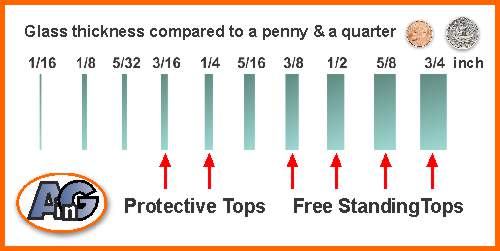
For protecting wood tables, the best thickness is 1/4″ although 3/16″ thick glass is OK for small tables. For approximate retail prices in Southern Arizona – jump to this comprehensive pricing site.
For free-standing tops (that is, glass supported by pedestals or legs) glass must be stronger and therefore heavier. 3/8″ or 1/2″ thick glass is the most popular with 3/4″ being the choice for super-luxury tables.
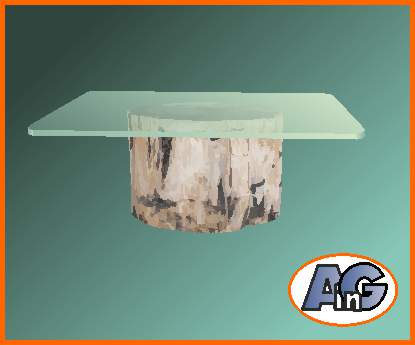
Free-standing tops should be thicker than 1/4″ and the most popular choice is 1/2″ glass. 3/8″ is more economical and OK for smaller tables, whereas top-of-the-line 3/4″ thick glass is heavy, expensive, and makes a real architectural statement. Follow this link for Southern Arizona retail prices.
Glass tops are replaceable
Remember that your antique Sheraton or Chippendale buffet is not replaceable so a scratch or stain is something you will have to live with and regret with great remorse.
In contrast, a scratched glass tabletop can easily be replaced.
If you have a standard-size circular top less than about 40″ in diameter – check out the prices from online glass companies. They often offer free shipping and very competitive prices.
This 24″ diameter, 1/2″ thick beveled glass tabletop is a real bargain – especially as it is advertised with free shipping.
Esthetic benefits of glass tops
The transparency, modernity, and variety of finishes make glass a favorite material for the creative designer, architect, or homeowner. Learn about the beauty of glass in this section:
Glass is transparent
The essence of glass is its transparency – this property lightens the room with reflected and transmitted light avoiding the heaviness of opaque wooden furniture.
It is hard to believe that for centuries, tables were made of heavy wood or even marble. Groaning tables full of venison fed the kings of Europe and the princes of the Gilded Age in the USA. Now elegance characterizes dining rooms all around the world as lighter cleaner glass brightens the eating experience.
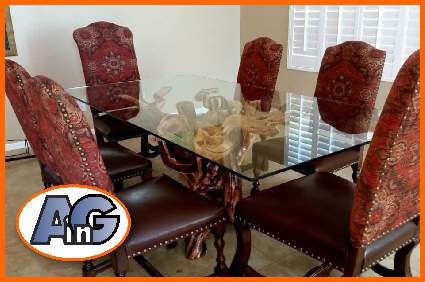
Glass is modern
Exciting modernity is the zeitgeist of glass – with post-modern furniture seldom seen in pre-war homes. The contemporaneous style of glass is especially seen in curved and bent glass furniture – like this elegant side table available on Amazon:
Minimalist design characterizes this 24″ tall, S-shaped end table, is ideal for your bedroom or den, and will go well with any other living room furniture. Made from 1/4″ thick tempered glass this table is strong and easy to clean.
Glass is versatile
Glass tabletops have numerous uses from small coffee & side tables to buffets & credenzas and heavy formal dining tables and patio tables.
Consider glass for all your household tables: for work or craft tables – economize by ordering seamed rather than polished edges. learn all about glass edgework in this informative post.
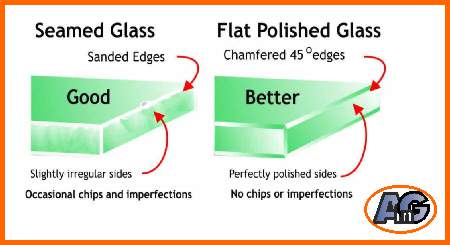
A seamed edge is slightly irregular but perfectly safe. The sharp edge of the glass is sanded down so that it will not cut you. Seamed edges are recommended for work tables where the appearance of the edge is not important.
Glass comes in many varieties
Although glass is archetypically transparent, it comes in several attractive colors or tints. It can also be sandblasted or even painted to produce a translucent or opaque finish:
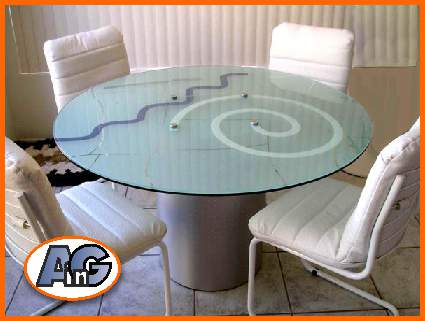
By far the most popular type of glass is affordable “clear” float glass that has a pale green tint owing to a low iron of iron oxide.
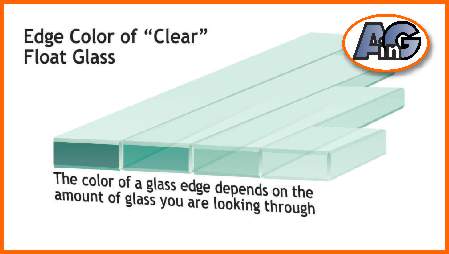
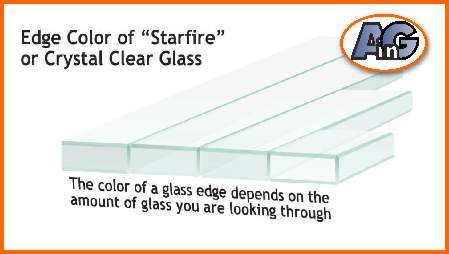
The green tint is only really obvious on long edges, but fastidious customers or museum curators often choose expensive, low-iron glass that has a pale aquamarine tint in long sections (see above).
Other popular tints are bronze (looks great with rusty patina) and gray (for a high-tech look).
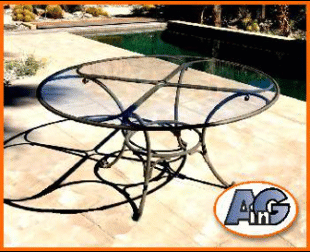
Study this Artistry in Glass post to learn about the tints available in architectural glass.
Glass fosters creativity
A glass tabletop is like a blank canvas upon, and under which the creative designer can place the base or support of her choice. The table and its base become parts of a single work of art.
In this spectacular example, a motorcycle enthusiast has used bike components to create a unique table with stools. Artistry in glass provided the crowning glory with a 3/4″ clear glass tabletop.
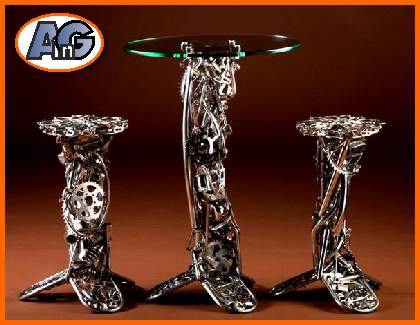
Even online retailers like Amazon have attractive side tables with amazing bases:

24″ high coffee table features a large wolf head with a smaller wolf howling next to birch trees. Tempered glass top is 1/2 inch thick & 19″ in diameter.
Choose your own base and coordinate with your local glass company to create a suitable glass tabletop.
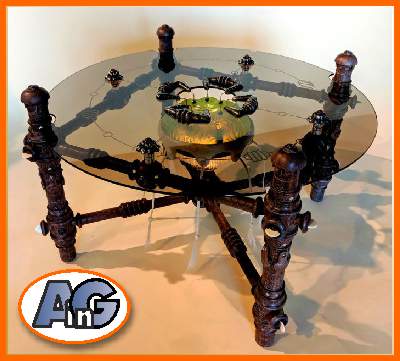
Benefits of glass tabletops
Practical and esthetic reasons make glass the go-to material for tabletops in the 21st century. Consult your glass retailer for expert advice on the best options of thickness, size, edgework, and color (tint) for your next tabletop, Southern Arizona customers – contact Artistry in Glass – your glass tabletop expert.
Glass tabletops & shelves – info from Artistry in Glass
- Benefits of glass shelving – info from experts!
- How much do glass tabletops cost?
- Do glass shelves need to be tempered?
- What is the best thickness for glass shelves?
- Best edge type for glass shelves, polished or beveled?
- How much weight can a wall shelf carry?
- What color glass should my shelves be?
- Glass tabletops – 10 amazing benefits explained
- How to order a glass tabletop
- Best thickness for glass tabletops – expert advice
- Should glass tabletops be tempered?
- Should glass tabletops be beveled?
- How to paint a glass tabletop
- All about tempering glass tabletops!
- How to tell if your glass is tempered
- Can tempered glass be cut?
- How to protect your wood table with glass
- How to fix a scratched glass tabletop
- How to fix a chipped glass tabletop
- How to replace broken patio table glass
- How to measure for a glass tabletop
- Video – how to measure your tabletop
- Plexiglass vs glass – pros and cons
- Beveled glass table base – a case study
- Choosing between tempered & laminated glass
- Glossary of terms used in the glass business
Unique Mirror Resources from Artistry in Glass
Mirror Design & layout
- How are mirrors made?
- What is a beveled mirror?
- What is a two-way mirror?
- Best mirrors for bedrooms
- How to size and position your wall mirror
- How to order custom etched mirrors
- Best places to hang dining room mirrors
- How much do wall mirrors cost?
- Shop the MIRROR Family Package
Mirror Installation & Removal
- How to hang a wall mirror
- How to frame a builder’s grade bathroom mirror
- How to hang a frameless mirror with glue
- Best clips for hanging mirrors
- How to attach a mirror to a closet door
- How to remove a mirror glued to the wall







